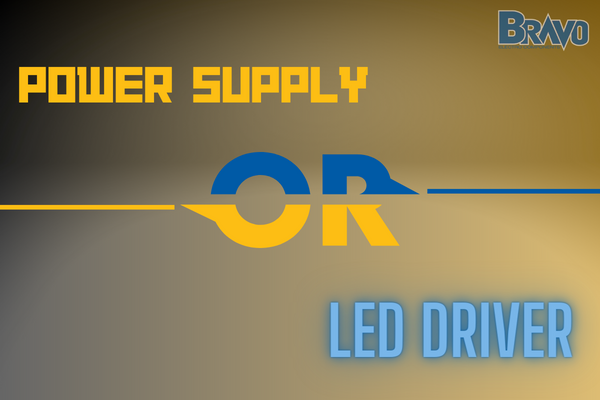
Have you ever wondered what the difference between a LED driver vs power supply is?
Despite their similar names, and both being used to provide power to electronic devices, there are significant differences between them. While LED drivers and traditional AC DC power supplies are distinct from each other, they can sometimes be referred to interchangeably as LED power supplies - though this is not always the case.
In this article, we'll discuss the differences between LED drivers and traditional power supplies, as well as offer purchasing tips to help you find the perfect solution for your situation.
First, Understand That an LED Driver is a Power Supply - Designed Specifically for LEDs
Before diving into the differences between an LED driver and a power supply, it's important to understand that a LED driver is indeed a type of power supply.
Specifically, it is a power supply designed to provide the current necessary for lighting applications such as LEDs. As opposed to conventional AC DC power supplies that supply energy to various appliances, LED drivers are made specifically for LEDs.
Because of this differentiation, LED drivers are able to optimize the performance of LEDs. LED driver is the most accurate term. This provides many advantages over AC DC power supplies: greater efficiency, more precise voltage control, and protection from excessive current/voltage which can damage your lights.
Since improper use of an LED driver or AC DC power supply could lead to less-than-optimal performance or even failure, understanding the difference between LED driver vs power supply is essential for any consumer or commercial user looking to purchase quality lighting devices.
LED drivers, on this note, offer higher voltage accuracy and more efficient operation than traditional AC DC power supplies - both of which contribute to increased reliability and longevity in lighting systems.
Additionally, LED drivers often come with extra features like dimming capabilities which aren't available in standard AC DC power sources.
Moreover, due to their smaller size, LED drivers can fit in compact spaces where larger AC DC power supplies cannot go which gives them further practicality in some situations.
What’s the Difference Between an LED Driver vs Power Supply for Other Devices?
Apart from being designed for LEDs, the differences between an LED driver and a power supply for other devices are quite significant. For instance, AC DC power supplies are typically used to provide household electricity and support a variety of appliances such as computers, TVs, and microwaves.
Unlike LED drivers, they generally feature a wide range of voltage options, can handle both AC or DC output, and offer much higher wattages than what is necessary for lighting applications. On that note, what’s the difference between AC and DC power anyway? And is household electricity AC or DC?
AC power is alternating current, meaning the voltage periodically changes direction while DC power is direct current and stays constant. AC DC power supplies typically include a rectifier to convert the AC voltage into DC, enabling it to be used by electronics.
Household electricity is AC power, with an output voltage of 110 - 120 Vac or 220 - 240 Vac depending on the region.
The voltage can be converted to 50Vdc or 60Vdc through a rectifier and then regulated down to whatever DC voltage is necessary for the device being powered. You may opt for either high-voltage power supplies or low voltage depending on what type of application it will be used in.
You could also opt for a modular power supply which allows for later expansion - though these are more expensive compared to traditional fixed models. That being said, bad power supply symptoms can vary from excessive heat emission to unexplained shutdowns so it's important to have backups in case something goes wrong.
When comparing an LED driver vs traditional AC DC power supplies in terms of cost-effectiveness and longevity you should consider not only their initial price but also their total energy savings over time due to lower wattage consumption and improved power supply efficiency rates afforded by LED drivers.
Ultimately, however, no matter what device you require power for - understanding the differences between LED drivers versus traditional AC DC devices will help ensure that you make the most informed purchase possible.
Can I Use an LED Driver as Power Supply for a Different Device?
Generally speaking, LED drivers are designed to supply LEDs with the current and voltage they need to function properly.
However, there can be cases where an LED driver could be used as a power supply for other devices such as computers, TVs, and microwaves - though it is important to understand certain factors first.
Unlike traditional AC DC power supplies, LED drivers provide specific currents or voltages tailored for lighting applications - meaning the wattage provided may not be enough for your device which could result in unwanted operation or even damage.
Therefore, it’s best practice to research the requirements of your device prior to using an LED driver as a power supply. This includes its wattage rating, efficiency rating, and power supply sizing requirements.
It’s also important to check and understand the difference between UL listed vs UL recognized power supplies and whether it requires either AC or DC output.
In addition, when trying out any type of power source it’s important to watch out for any signs that something isn’t working as intended such as excessive heat emission or unexplained shutdowns. This way you can quickly swap out your power source before more serious issues arise.
So while an LED driver may sometimes be suitable as a substitute power source for other devices - AC DC sources will usually remain the better option due to their greater wattage capabilities and power supply voltage options better suited for most applications.
Finding the right power source for whatever device you’re using can be a tricky process. It is important to understand the various factors that come into play when selecting the best LED driver or power supply for your unique needs.
Tips for Finding the Right LED Driver or Power Supply for Your Unique Needs
Beyond the scope of led driver vs led power supply, here are some tips for finding the right power source for your device:
Consider Your Application
First and foremost, think of the application - what type of device is it going to be powering? This should determine whether an LED driver or a power supply would be more suitable as well as other considerations such as wattage rating, efficiency rating, and size requirements.
Utilize Resources
Research is key in finding the right power source. There are numerous resources available online that can provide helpful insights on selecting a product that is suited to your specific needs.
Additionally, speaking with experienced professionals who have knowledge of these products and their applications can also help make sure you make the best choice possible.
Class 2 vs Class II Power Supply
Class 2 and Class II Power Supply Units (PSUs) differ in terms of their output capability.
The former offers limited protection for its electrical yield, whereas the latter provides superior safety features that safeguard customers from electric shock hazards as well as reduce fire risks caused by short circuits or overloads within electronic devices.
Look for UL Listings & Recognition
UL stands for Underwriters Laboratories which is an independent product safety company that tests and evaluates products for safety compliance before they reach the market.
When selecting a power source look for any UL listing or recognition which indicates that it has been tested and evaluated by this third-party organization before release - providing added confidence when making your purchase decision.
Open Frame vs Enclosed Power Supply
When selecting a power supply it’s important to decide whether you want an open frame or enclosed design depending on your application needs.
With open frame designs, you get more flexibility as custom mounting possibilities become available as well as increased airflow although wiring can be tricky due to cluttering up interior space with cords.
On the other hand, enclosed designs feature a metal case which allows for easy installation but decreased airflow can lead to overheating issues if not properly taken care of beforehand!
Find Out About Warranty & Support
Before buying a LED driver or power supply make sure to look at what kind of warranty or support services are provided by the manufacturer or supplier.
Many companies will provide help through installation guides, after-sale technical support, and other customer service-related services. This is usually true regardless of whether you pick an LED driver vs LED power supply. So make sure to check these out before committing to a purchase.
Whether You Need an LED Driver vs Power Supply, You Can Find it at Bravo Electro!
At Bravo Electro, we have the perfect power source for any of your projects. Our selection of LED driver power supply and AC DC power supplies cover all the bases, including 12V power supplies, 24V power supply, to 48V power supply.
Whether you need an LED driver or a power supply, like a high-efficiency Switch Mode Power Supply (SMPS), we've got it all in stock.
Our range includes programmable models with adjustable output voltage and current that can be customized for your specific needs. And to top it off, all our products come with a manufacturer's warranty as well as technical support should you ever need it.
Parting Thoughts on LED Drivers vs Power Supplies
The topic of LED driver vs LED power supply can be confusing at first. However, you now have the necessary information to make an informed decision on selecting the right power source for your device.
Take time to research and look at all available options before committing to a purchase. And when you're ready to make a purchase, Bravo Electro is here to help - we have an extensive selection of LED drivers and power supplies that are perfect for any application.
So, what are you waiting for? Start your search today!










